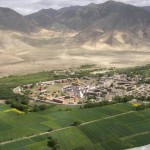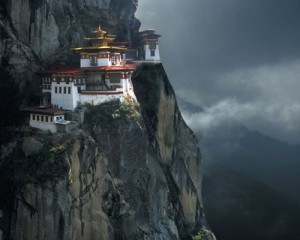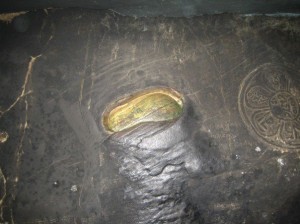Guru Rinpoche
In the north-western part of the land of Oddiyana, on an island in the lake of Dhanakosha, the blessings of all the buddhas took shape in the form of a multi-coloured lotus flower. Moved by compassion at the suffering of sentient beings, the Buddha Amitabha sent out from his heart a golden vajra, marked with the syllable HRIH, which descended onto the lotus blossom. It transformed into an exquisitely beautiful eight year old child, endowed with all the major and minor marks of perfection, and holding a vajra and a lotus. At that moment all the buddhas of the ten directions, together with hundreds of thousands of dakinis from different celestial realms, invoked the blessings and the incarnation of all the buddhas for the benefit of beings and the flourishing of the secret mantra teachings. Their invocation is known as ‘The Seven Verses of the Vajra’, or ‘The Seven line Prayer.”
In Tibet
Now, the thirty seventh king of Tibet, Trisong Detsen, had invited the great pandita Shantarakshita, also known as Khenpo Bodhisattva, to establish Buddhism in his country. The author of the famous Ornament of the Middle Way (Skt. Madhyamakalamkara) and Compendium on Reality (Skt. Tattvasamgraha), Shantarakshita began teaching in Tibet, and laid the foundations for Samyé monastery. This provoked the local spirits, who embarked on a campaign of disasters—disease, floods, storms, hail, famine and drought—and whatever construction work was done at Samyé during the day was dismantled at night. Shantarakshita urged the king to invite Guru Rinpoche, and he despatched envoys under the leadership of Nanam Dorje Dudjom. With his prescience, Guru Rinpoche knew already of their mission, and had gone to meet them at Mangyul, between Nepal and Tibet. According to Kyabjé Dudjom Rinpoche, it was in the Iron Tiger year (810) that Padmasambhava came to Tibet. It is said that he was then over a thousand years old. On the way to central Tibet, he began to subjugate the local spirits and made them take oaths to protect the Dharma and its followers. He met the king at the Tamarisk Forest at Red Rock, and then went to the top of Mount Hépori and brought all the ‘gods and demons’ of Tibet under his command.
Glorious Samyé—the Inconceivable—the unchanging, spontaneously accomplished temple’ was then built without any hindrance, completed within five years, and consecrated, amidst miraculous and auspicious signs, by Guru Rinpoche and Shantarakshita.
There then began a vast undertaking, an extraordinary wave of spiritual activity in Tibet. Vimalamitra and other great
scholars and masters, one hundred and eight in all, were invited; Guru Rinpoche, Shantarakshita and Vimalamitra gave teachings, and then worked with Tibetan translators, such as Vairotsana, Kawa Paltsek, Chokro Lüi Gyaltsen and Shyang Yeshé Dé, to translate the sutras, tantras and treatises into Tibetan; the first seven Tibetan monks were ordained into the Sarvastivadin lineage, and this was the time when the two sanghas, the monastic celibate sangha of monks and nuns and the community of lay tantric practitioners, came into being in Tibet; and Vairotsana and Namkhé Nyingpo were despatched to India to receive teachings, on Dzogchen from Shri Singha, and on Yangdak from Hungkara, respectively.
At King Trisong Detsen’s request, Guru Rinpoche opened the mandala of the vajrayana teachings in the caves of Chimphu above Samyé to the twenty-five disciples, headed by the King Trisong Detsen, Yeshé Tsogyal and Vairotsana; nine of the twenty-five attained siddhis through practising the sadhanas he transmitted to them. It is said that he convened them in three great gatherings, to teach the Kagyé Deshek Düpa, the Lama Gongdü, and the Kadü Chökyi Gyatso.
Guru Rinpoche and his closest disciple Yeshé Tsogyal travelled all over Tibet and the Himalayas, and blessed and consecrated the entire land, especially: “the twenty snow mountains of Ngari, the twenty-one sadhana places of Ü and Tsang, the twenty-five great pilgrimage places of Dokham, the three hidden lands, five ravines, three valleys and one region.”
Guru Rinpoche made many prophecies about the future, and together with Yeshé Tsogyal concealed countless terma teachings, in order to: prevent the destruction of the teachings of the secret mantrayana; avoid corruption of the vajrayana or its alteration by intellectuals; preserve the blessing; and benefit future followers. For each of these terma treasures, he predicted the time for its revelation, the identity of the revealer, and those who would receive and hold the teachings. At thirteen different places called Tiger’s Lair, Taktsang, Guru Rinpoche manifested in “the terrifying wrathful form of crazy wisdom”, binding worldly spirits under oath to protect the terma treasures and serve the Dharma. Then he was named Dorje Drolö, ‘Wild Wrathful Vajra’.
At Shyotö Tidrö in the Drikhung Valley, the great Guru transmitted the teachings of Dzogpachenpo, the Innermost, Unsurpassed Cycle of the Category of Pith Instructions, and the Khandro Nyingtik, to a single human disciple, Yeshé Tsogyal, and a hundred thousand wisdom dakinis. Later, at Chimphu, when Trisong Detsen’s daughter, the princess Pema Sel, died at the age of eight, Guru Rinpoche drew a red syllable NRI on her heart, summoned her consciousness, restored her to life and gave her the transmission of the Nyingtik teachings, soon after which she passed away. Yeshé Tsogyal concealed the teachings as terma, and centuries later, Pema Sel’s incarnation, the master Pema Ledreltsal, revealed the Khandro Nyingtik cycle. His next rebirth was as the omniscient Longchen Rabjam.
After the death of Trisong Detsen, Guru Rinpoche stayed on in Tibet into the reign of his successors. But he knew that the rakshasa cannibal demons, inhabiting the south-western continent of Chamara—Ngayab—were set to invade and destroy India, Nepal and Tibet, and if not subdued, they would sweep the earth and destroy all human life. So, after fifty five and a half years in Tibet, in the Wood Monkey year (864), Guru Rinpoche prepared to leave, and went, accompanied by the young king Mutik Tsepo and a large gathering of disciples, to the pass of Gungthang in Mangyul. They implored him to stay, but he refused. He gave final teachings and instructions to each of them, and then, on the tenth day of the monkey month, left for the land of Ngayab Ling in the southwest, and for his manifested pure land on Zangdokpalri, the Copper Coloured Mountain of Glory.
The many accounts of his life vie in their beauty when they come to describe his departure. The Zanglingma biography says that after giving his final instructions, “Padmasambhava mounted a beam of sunlight and in the flicker of a moment soared away into the open sky. From the direction of the south west, he turned his face to look back, and sent forth a light ray of immeasurable loving kindness that established the disciples in the state of non-return. Accompanied by a cloud-like throng of dakinis, outer and inner, and amid the sound of the music they were offering, he went to the south-western continent of Ngayab.” But different people had different perceptions of his departure. Some saw him leaving in swirling clouds of coloured light, mounted on a divine horse; others saw him riding a lion. In some accounts, the twenty-five disciples in their meditation watched him receding in the sun’s rays, first the size of a raven, then a dove, a sparrow, a bee, and finally a tiny speck that disappeared from sight. They saw him alighting in the land of the rakshasas and teaching them the Dharma.
On the peak of the Copper Coloured Mountain, Guru Rinpoche liberated the king of the rakshasas, Raksha Thötreng, and assumed his form. Now he dwells in Zangdokpalri as a ‘vidyadhara of spontaneous presence’, the fourth vidyadhara level: “There,” writes Kyabjé Dudjom Rinpoche, “he manifested the inconceivable Palace of Lotus Light, and there he presides as king, with one of his emanations in each of the eight continents of the rakshasas, giving teachings like the Eight Great Methods of Attainment of the Kagyé, and protecting the people of this world of Jambudvipa from fears for their life. Even to this day, he reigns as the regent of Vajradhara, the ‘vidyadhara with spontaneous accomplishment of the ultimate path’; and thus he will remain, without ever moving, until the end of the universe.”





